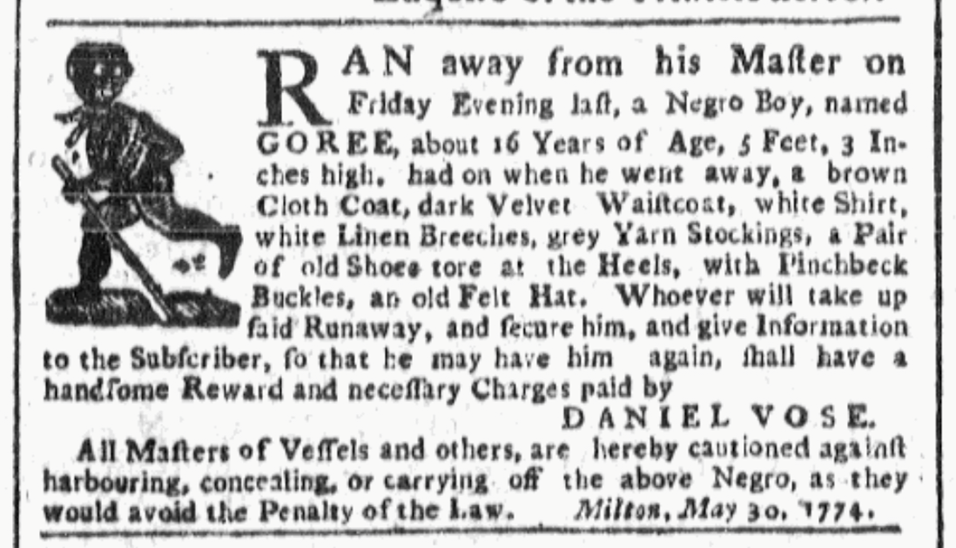Slave names tell stories, complex and nuanced ones. They document ties of sentiment between mothers and daughters. They represent lineages fathers bestow on their sons. Names also embody the hopes, dreams, and aspirations of parents, enslaved as well as free, who wanted a better life for their children.
For some enslaved African Americans like Goree, names signified a real and imagined point of self-transformation. Long before Malcolm Little remade himself into Malcolm X and later into El Hajj Malik El Shabazz, Goree chose a name that tells the story of an evolving African identity. In all likelihood, it was chosen not by the “Negro boy” but by the white man, Daniel Vose, who had purchased him as a commodity, subjected him to unpaid domestic service, and was intent on keeping him in bondage. The name identified the short, well-dressed 16-year-old fugitive with his point of origin. “Gorree” stood for the island opposite Dakar in contemporary Senegal, where more Africans were sold into slavery than anywhere else during the heyday of the Atlantic slave trade (15th to 19th centuries). A marker of deracination, the name signified not where he was born but where he was bought.[1]
Following his escape from Vose’s control, Goree not only sustained his independence during the unsettlement of the American Revolution, but also choose his own name. On Oct 10, 1782, almost a year before slavery was ruled a violation of the Massachusetts Constitution, a man named “Scipio Gorrey” came before Reverend Samuel Parker of Trinity Church in Boston and wed a woman named “Katherine Winship.” For the record, Parker noted that both bride and groom were “Negroes.” Was this the same youth for whom Vose had advertised? No other candidates appear in the records. The new name made for continuity in the man’s life, even as it allowed a measure of self-determination. He would take “Goree” as his surname and expunge any link to “Vose.” And he would embrace “Scipio” as his first name to deepen his attachment to an African home. Scipio Africanus was the Roman general and statesman who defeated Hannibal at the Battle of Zama in 202 BC. The name was a familiar one in the 18th century. Goree might have even known the story of its classical origins. At least two dozen men named Scipio served as soldiers in Massachusetts military units during the War of Independence. While Scipio Gorrey was not among them, he affirmed himself as a Black Bostonian and a proud African in other ways.[2]
But he struggled to sustain an enduring family. The union with Katherine was over by August, 1792, when a “Scipeo Gorres” and Patience Stratback posted an intention to wed at Trinity Church. Two years later he married another Patience, with the surname Stinger, on Nov. 19, 1794. The union was short-lived. For on Nov. 25, 1795, Scipeo Gorey exchanged vows with a woman identified variously as Isabella and Elizabeth Cary, this time at Brattle Street Church. This fourth marriage took, overcoming the scourges of poverty and disease that cut short so many families of color.
The couple lived in the new Black community that took shape close to Belknap Street on the west side of Beacon Hill. With Elizabeth by his side, Gorey made a life for himself, although they apparently never had any children. In 1813 his name appeared in the Boston Directory among the “Africans” in the municipality. They may have attended the nearby African Baptist Church, of which Scipio Dalton had been a founder in 1806. Gorey was included in the federal census of Massachusetts as a “Coloured” head of a family in Boston’s Ward 6. His occupation was general “laborer.” Some four decades after he freed himself from Daniel Vose’s control, Gorey was living less than a mile from the historic district in Boston where printers had clustered to turn out pamphlets in defense of American liberty and advertisements for the return of fugitive slaves.[3]
Two years later, on Oct 16, 1822, Scipio Gorey was dead at age 53 of consumption (now known as tuberculosis). His passing was noted in the Trinity Church records. The Episcopal Church, which welcomed Blacks into its fold, still considered him a parishioner, whether he worshiped there or not. In the spare records of the town and church he left behind the story of one freedom seeker, who held firm in the determination to command his own destiny.[4]
Read another story about Goree.
View References
[1] Vose paid for eight advertisements in four different newspapers for the apprehension and return of Goree. See Boston Post-Boy, May 23, 1774, 3; Boston Evening Post, May 30, 1774, 3; Boston Gazette, May 30, 1774, 3, June 13, 1774, 4; Essex Gazette, May 31, 1774, 172; Boston Evening-Post, June 6, 1774, 4; Essex Gazette, June 7, 1774, 177; Essex Gazette, June 14, 1774, 181.
[2]. For useful reading of runaway advertisements as narratives in which enslaved African American cosigned their own life stories, see David Waldstreicher, “Reading the Runaways: Self-Fashioning, Print Culture, and Confidence in Slavery in the Eighteenth-Century Mid-Atlantic” William and Mary Quarterly 56.2 (April 1999): 243-272; and, Antonio T. Bly, “‘Indubitable signs’: reading silence as text in New England runaway slave advertisements” Slavery & Abolition 42.2 (2021): 240-268.
[3] Richard A. Gabriel, Scipio Africanus: Rome’s Greatest General (Washington, D.C., Potomac Books, Inc., 2008), chapter 2.
[4] [Marriages Registered in Boston], Jay Mack Holbrook, Massachusetts Vital Records, Boston 1630-1849 (Oxford: Massachusetts: Holbrook Research Institute, 1984), 252 in https://www.ancestry.com/imageviewer/collections/2495/images/40400_274635-00253?treeid=&personid=&rc=&queryId=90a86fb3-18c9-4988-b748-d45825651b6e&usePUB=true&_phsrc=jhP84&_phstart=successSource&pId=47058045; [Deaths and Interments in Boston], Jay Mack Holbrook, Massachusetts Vital Records, Boston 1630-1849 (Oxford: Massachusetts: Holbrook Research Institute, 1985), 16548 in https://www.ancestry.com/imageviewer/collections/2495/images/40902_264065__0474-00018?treeid=&personid=&rc=&queryId=1d664664-83a7-4fd8-9b62-9f93dfa83c0b&usePUB=true&_phsrc=jhP77&_phstart=successSource&pId=8515361.
